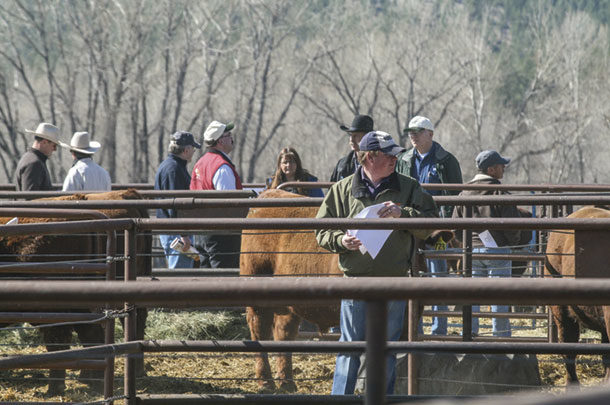From that standpoint, it is clear that most if not all genetic progress is made through sire selection. Therefore, this single decision can have lasting impacts for multiple years and generations.
However, with a strategic approach, the identification of the next herd sire can be simplified. In today’s industry, producers have access to more genetic information than ever before. At times this data can be difficult for producers to interpret and apply correctly. Overwhelming amounts of data coupled with phenotypic evaluation can cause producers to lose focus on what is important for their program to be successful.
In order to mitigate this risk, producers should first identify what is important in their respective operations before viewing bulls. Like any sound business plan, cattle producers need to identify their target goals and markets and select a bull that can help meet those goals. Emphasized traits must match the environment of the operation, and producers must remember that not all genetic data will fit into their goals.
When identifying needed traits, producers should:
- Look at the current cow base and past production records
- Develop and prioritize a list of traits to improve
The combination of records and visual appraisal will help identify strengths and weakness of the cow herd. Additionally, it may also reveal females that need to be culled as an added benefit. A prioritized list of criteria will help focus areas to emphasize when evaluating herd sires. Keep in mind, the longer the list the harder it will be to find a single bull that checks all the boxes. Therefore, initial selection should focus on the highest priority areas to achieve the outlined goals. In future years, lower priorities can be targeted with additional bull purchases.
Genetic data
Based on identified cow needs, producers can then begin to evaluate available sires that help achieve the operation’s goals. Just like with the base cow herd, a combinational use of genetics and phenotype should be applied. In general, genetic data can be classified into broad categories: maternal traits, growth traits, carcass and/or terminal traits, etc. It is important to understand these and apply them appropriately to your selection process. Traits such as calving ease, birthweight, weaning weight, yearling weight and milk can all be classified into maternal and growth traits.
Traits like weaning and yearling weight can be reflective of the calf’s genetic growth ability, and in the case of weaning weight, a portion of this growth can be attributed to the maternal ability of the dam. Carcass traits can indicate the genetic potential for muscle mass as well as post-harvest traits. It is important to remember that expression of genetic traits is influenced by the environment and management as well. In addition, most breed associations have developed indexes that combine multiple traits into a single number.
These allow for improvements in multiple areas while using a single data point. Indexes can be used to select for improved carcass and/or terminal traits or move toward more maternal replacement traits. A few examples of these include $B (beef value), $W (weaned calf value), $F (feedlot value) in the Angus breed; $API (all purpose index), $TI (terminal index) in the Simmental breed; and $BMI (baldy maternal index) in the Hereford breed, just to highlight a few.
Understanding the difference in data categories can help refine the selection process and allow emphasis on only traits that fit the operation’s goals and environment. Producers interested in retaining replacement females can emphasize maternal traits, whereas those selling or retaining ownership in fed cattle may emphasize the carcass traits. This decision must also balance environmental conditions of the operation.
Areas with limited feed resources may require a different level of milk and growth traits that may demand additional supplement when natural forage availability is low. Some of this genetic information can be complex and overwhelming; remember that asking questions of other breeders, extension faculty or breed association representatives will help producers determine what is best for their operation.
Physical traits
Regardless of genetics, physical traits allow a bull to deliver his genetic information during breeding season. Therefore, the phenotype should not be overlooked when selecting a bull. Visual traits have been utilized for centuries to identify parent stock. Basic fundamentals have not changed and if kept simple are not difficult to evaluate and implement. Key physical traits to keep in mind are structural correctness, body volume and reproductive traits.
Animals must be structurally sound (able to move comfortably) to travel and withstand mating pressures. Structural evaluation begins with hoof placement and design; this sets the foundation for skeletal comfort and can determine how a bull walks. In addition, joint angle will determine his flexibility and if constructed correctly can add to a bull’s longevity. Bulls that lack correct structural design tend to be less comfortable and will travel less, leading to decreased performance and reproduction.
In addition, bulls should have enough body space and/or capacity in their rib cage and abdomen to consume, digest and utilize feedstuffs to maintain body condition. Integrated with body capacity, is the potential for muscle mass. Animals that are wider-constructed and higher-volume also tend to be heavier-muscled. This visual evaluation coupled with genetic muscle and carcass traits can highlight the combinational use of genetic and physical traits.
Reproduction traits
Reproduction traits including semen, fertility and reproduction EPDs, and visual evaluation of the reproductive tract are still important in sire selection. Physical reproduction traits can and do change with environmental influences. Therefore, it is important to regularly evaluate a bull’s testes to ensure they appear normal. Visually, they should be similar in size, even in descent from the body and the scrotal neck should not be twisted. Any alterations in these traits may indicate underlying reproductive issues, and your veterinarian should be consulted.
In addition, it is always important to have a complete breeding soundness exam performed by your veterinarian prior to breeding season. A breeding soundness exam provides key indicators of semen quality and morphology that may influence fertility. Identifying problems early allows for replacements to be identified before breeding season begins.
Ultimately, producers need to develop a strategic list of what is needed in a herd sire to reach their operational goals. These traits need to match the environment and be used in combinations to prevent single trait selection. By adopting this approach, producers can be more confident they are selecting the correct bull for their operation. ![]()
PHOTO: Selecting a bull is a decision that can have lasting impacts for years and generations. Choose wisely. Photo by Paul Marchant.

-
David Roper
- Assistant Professor
- Judging Program Coordinator
- Tarleton State University
- Email David Roper









